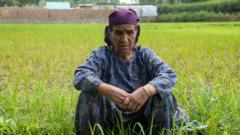Despite a brief respite from recent rains, Kashmir is facing an unprecedented heatwave that threatens the agricultural backbone of the region. Zaina Begum, a farmer from Pulwama district, expressed despair as her paddy fields shrivel under the extreme conditions, unable to withstand the high temperatures, which have surged to record levels—hitting 37.4°C this month, marking the hottest June in half a century. With a reliance on farming for survival, locals are grappling with diminishing water supplies disrupting their crop yields, and harsh consequences of climate change loom ever larger.
Experts note that three heatwaves have already impacted the area this season. An alarming 2°C temperature rise has been recorded since 1980, correlating with significant global climate disparities. Agricultural shifts are evident; many farmers, like Ali Mohammad who transitioned from rice to apples two decades ago, now also face drastic declines in fruit yield due to inadequate rainfall and drying irrigation sources. This year signifies the culmination of ongoing agricultural distress, with crops failing after years of inconsistent rainfall patterns, prompting residents like 63-year-old Parveez Ahmad to confront newfound health challenges due to scorching heat.
Environmental scientists highlight that reducing snowfall and accelerated glacier melting present serious implications for water security across Kashmir, deepening the cyclical crises that threaten both health and harvests. As winter precipitation decreases, and urbanization encroaches upon vital agricultural lands, the locals are caught in a stark reality; they are among the least contributors to greenhouse gas emissions yet bear the brunt of changing climatic conditions.
Despite urgent calls for political prioritization of environmental crises, governmental responses seem sluggish. Critics argue that without immediate and concerted efforts to address these environmental challenges, the fate of farming communities hangs in the balance, echoing the sentiments of farmers like Ms. Begum, who anticipate a bleak future unless drastic measures emerge swiftly. As temperatures climb and the climate crisis deepens, Kashmir’s agricultural heart faces an uncertain and daunting future.
Experts note that three heatwaves have already impacted the area this season. An alarming 2°C temperature rise has been recorded since 1980, correlating with significant global climate disparities. Agricultural shifts are evident; many farmers, like Ali Mohammad who transitioned from rice to apples two decades ago, now also face drastic declines in fruit yield due to inadequate rainfall and drying irrigation sources. This year signifies the culmination of ongoing agricultural distress, with crops failing after years of inconsistent rainfall patterns, prompting residents like 63-year-old Parveez Ahmad to confront newfound health challenges due to scorching heat.
Environmental scientists highlight that reducing snowfall and accelerated glacier melting present serious implications for water security across Kashmir, deepening the cyclical crises that threaten both health and harvests. As winter precipitation decreases, and urbanization encroaches upon vital agricultural lands, the locals are caught in a stark reality; they are among the least contributors to greenhouse gas emissions yet bear the brunt of changing climatic conditions.
Despite urgent calls for political prioritization of environmental crises, governmental responses seem sluggish. Critics argue that without immediate and concerted efforts to address these environmental challenges, the fate of farming communities hangs in the balance, echoing the sentiments of farmers like Ms. Begum, who anticipate a bleak future unless drastic measures emerge swiftly. As temperatures climb and the climate crisis deepens, Kashmir’s agricultural heart faces an uncertain and daunting future.





















